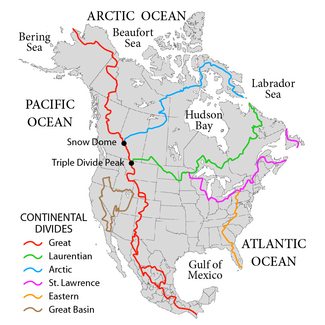| This article needs additional citations for verification. Please help improve this article by adding citations to reliable sources. Unsourced material may be challenged and removed. Find sources: "St. Lawrence River Divide" – news · newspapers · books · scholar · JSTOR (January 2023) (Learn how and when to remove this message) |
Download coordinates as:


The Saint Lawrence River Divide is a continental divide in central and eastern North America that separates the Great Lakes-St. Lawrence River Basin from the southerly Atlantic Ocean watersheds. Water, including rainfall and snowfall, lakes, rivers and streams, north and west of the divide, drains into the Gulf of St. Lawrence or the Labrador Sea; water south and east of the divide drains into the Atlantic Ocean (east of the Eastern Continental Divide, ECD) or Gulf of Mexico (west of the ECD). The divide is one of six continental divides in North America that demarcate several watersheds that flow to different gulfs, seas or oceans.
Course
West of the triple divide
The divide has its origin at ‘Hill of Three Waters’ triple divide on the Laurentian Divide approx. 2 miles north of Hibbing, Minnesota. It follows the western boundary of the Saint Louis River watershed, and then winds through the Northern Highland of Wisconsin south of the shore of Lake Superior. It then follows the boundary between the Wisconsin River and Fox River watersheds.
In Illinois and Indiana, it follows the Valparaiso Moraine separating the watershed of Lake Michigan to the north from that of the Illinois River to the south. Between roughly South Bend and Fort Wayne the divide zig-zags among hilly terrain. After that it follows the Wabash Moraine in western Ohio, separating the first the watersheds of the Maumee River to the north and Wabash River to the south, and later the Sandusky River to the north from the Scioto River to the south.
The divide then generally parallels the Portage Escarpment near the southern shore of Lake Erie through eastern Ohio, Pennsylvania, and western New York. This portion's northern watersheds include several smaller rivers that drain directly to Lake Erie, the largest of which is the Cuyahoga River; the southern watersheds are the Muskingum River, Beaver River, and Allegheny River.
After passing around Chautauqua Lake, which is in the Allegheny River watershed, the divide turns away from Lake Erie and it crosses into the Allegheny Plateau region. It follows the boundary of Cattaraugus Creek and then the Genesee River basins to the north, while continuing to drain to the Allegheny River to the south. After reentering Pennsylvania, the St. Lawrence River divide meets the triple divide at the northern end of the Eastern Continental Divide.
East of the triple divide
Through central New York, the divide separates the Oswego River watershed, which contains most of the Finger Lakes region, to the north from the Susquehanna River basin to the south. The divide then follows the boundary of the Hudson River watershed to the south through the Adirondacks, dipping briefly south of Lake George and Lake Champlain before following the northern boundary of the Connecticut River watershed.
For its next stretch, the divide follows the boundary of the Saint John River watershed to the south. The divides becomes the international border between Maine and Quebec between the headwaters of Halls Stream and the Southwest Branch Saint John River. The divide then continues into the Notre-Dame Mountains in Quebec, then turns southeasterly through central New Brunswick.
From there, the divide borders the Petitcodiac River basin, crosses through the Isthmus of Chignecto, and runs easterly along the Cobequid Mountains along the northern coast of Nova Scotia and eventually to Cape Canso.
Hydrology
As the divide is generally in close proximity to each of the Great Lakes to the north, the rivers on this side of the divide are generally short. To the southwest, there are broader watersheds that are tributaries of the Upper Mississippi River and the Ohio River that ultimately drain to the Gulf of Mexico. To the southeast are several major river watersheds that drain directly to the Atlantic Ocean.
Canals
Four canals cross the divide: The Champlain Canal connects Lake Champlain to the Hudson River watershed. The Erie Canal connects Lake Erie to the Hudson River watershed. The Chicago Sanitary and Ship Canal crosses the Chicago Portage and connects Lake Michigan to the Mississippi River watershed. The Portage Canal connects the Fox River to the Wisconsin River at Portage, Wisconsin. Historically there were additional canals, e.g., the Ohio and Erie Canal, but most of these are no longer in operation.
Locations
| This list is incomplete; you can help by adding missing items. (November 2009) |
References
- "Limits of Oceans and Seas, 3rd edition" (PDF). International Hydrographic Organization. 1953. Retrieved 29 December 2020.
- Gonzalez, Mark; Joel Festa (2007). "Continental Divides in North Dakota and North America" (PDF). NDGS Newsletter. North Dakota Geographical Society. Retrieved 2016-01-19.
- "USGS/contours ArcGIS". ArcGIS. State of Ohio Dept. of Natural Resources. Retrieved 15 May 2016.
- Eastern Triple Divide